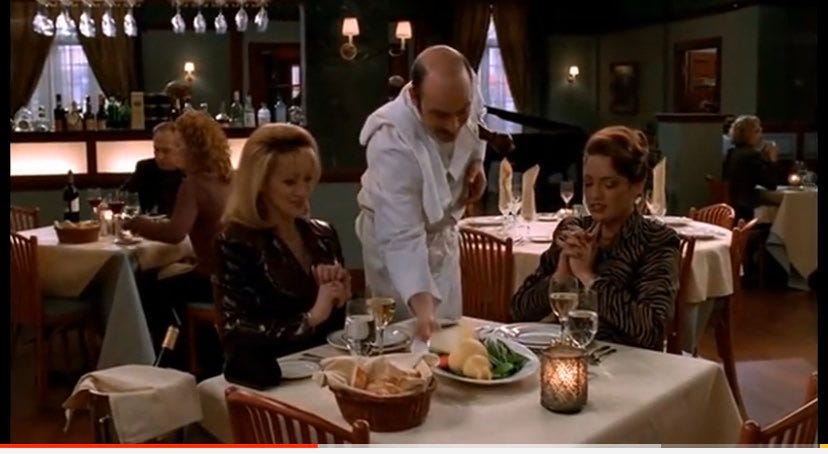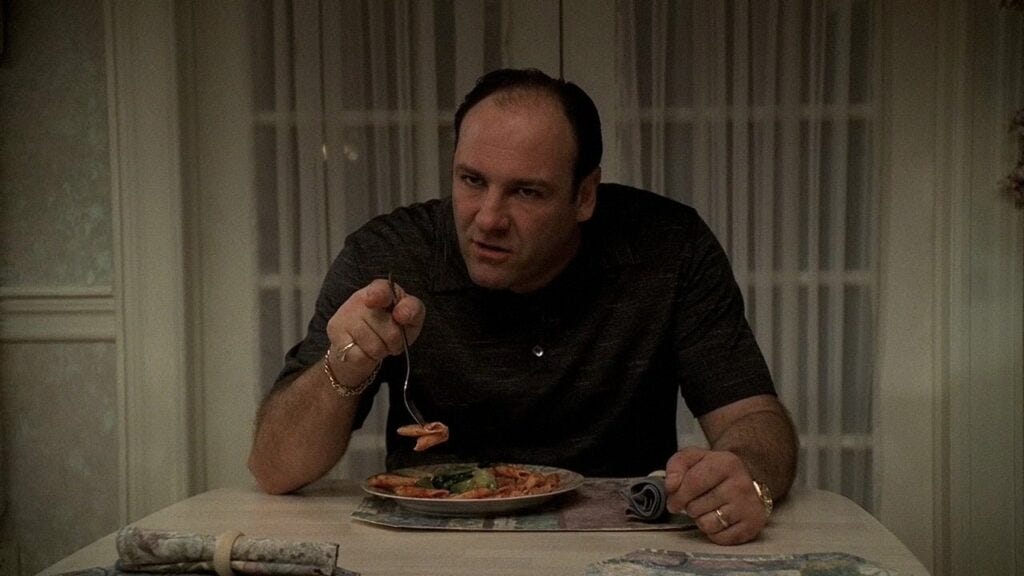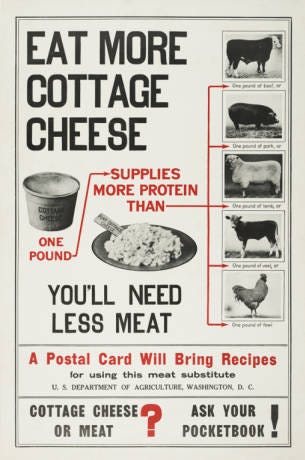burrata is an Italian cottage cheese dumpling
let me tell you why
Our home has been getting back into a modern classic of television, The Sopranos, over the past few months and it’s just as entertaining as promised. It’s been a great time capsule of life (I guess through the lens of the Mob 🤷🏻♂️) in the early 2000’s. The technology changed from pay phones to iconic burner flip phones. Eating dishes at Nuovo Vesuvio restaurant with Artie Bucco always pushing his new dishes on people. In fact, it was the ninth episode in season three, aptly called “The Telltale Moozadell,” where Chef Bucco tries to wow Carmela and Rosalie with a fine cheese he Fedexed all the way from the homeland: burrata.
They did not like burrata. Nobody liked burrata in 2001 because…we wanted gabagool and olives. And not to take the domain of my good friends at Yes, We’re Still Watching, but it made me think of an article I had read over the summer that made me chuckle. I went back to reread it and dive into Reddit threads about burrata becoming omnipresent. It’s strange that burrata has taken off in such a grand way and I now couldn’t get it off my mind that burrata is just cottage cheese gilded in moozadell (er…mozzarella). Here is my dive into why they’re part and parcel of your salad and, potentially, pizza revolutions.
quick history on burrata and cottage cheese
Burrata is a cheese that’s from a region in Southern Italy, called Puglia, in the heel of Italy. It’s typically attributed to the brothers Bianchino in 1956, when they had small scraps of mozzarella leftover they weren’t sure what to do with. The idea hatched into what has today become a chimera of two Italian cheeses: stracciatella and mozzarella. The often confusion-inducing stracciatella, which is also a type of ice cream and soup, is made by curdling cow or buffalo milk with rennet. These curds are separated from the whey and are stretched or torn into longer and snappier pieces of cheese with cream and salt added. Stracciatella comes from stracciare, meaning “to stretch,” which is how we get this name. Our mangled curds are then combined with cream and wrapped in a sheet of mozzarella. It is pure bliss cutting into one of these beauties and stealing as much of the stracciatel’ from the other wiseguys at your table as possible.
Cottage cheese has a storied history dating back to the 19th century of Minnesotans and sour milk. When the milk went bad and began to curdle, they would separate the curds from the whey to make “Dutch cheese” because I guess that’s how you make gouda in the eyes of frontiersmen. Shortly after the days of watching your turned milk drain in the cloth over your sink, cottage cheese production kicked up to an industrial endeavor in the early 1900’s. This was just in time for World War I to ration meat and widely promote protein-rich dairy products, cottage cheese principal among them. This continued a meteoric rise in the consumption of cottage cheese throughout the United States and Canada. Our appetite peaked in the 1970’s during the beginning of the dieting revolution, with $1.3 billion (over $5.7B today) in sales. And just as yogurt came into the American gaze, cottage cheese began its descent faster than it rose to fame.
As far as modern-day production goes, let me know if you’ve heard this one before:
Milk is curdled using rennet and a bacterial culture. Whey is separated from the curds and the former are then combined with salt and cream before being packaged.
Hmm, so we have cream and curds once again, albeit the curds aren’t pulled to the point of breaking. It seems that we’ve made an unstretched stracciatella mixed with cream and ready to be cozied up in mozzarella dough.
who cares if they’re the same thing?
I, for one, love both burrata and cottage cheese and I’m not about to flame either one for being similar to the other. What excites me about this Sopranos-induced revelation is that there’s a shortcut to a cheaper and omnipresent American stracciatella in every grocery store. You can dress it with a nice olive oil and pepper and have a mean roasted beet salad.
I’ve been experimenting with different ways to prepare cottage cheese to bump up its lowly status among food-minded folks. One of my new favorite ways to prepare it is in an emulsion that gives you all the beautiful flavors of stracciatella that you can keep and throw on top of soups, salads, and maybe even pizza.
Cottage Cheese Emulsion
Ingredients
1/2 cup (~110g) of your favorite small or large curd cottage cheese
1-2 garlic cloves
pinch of salt
a splash of balsamic or red wine vinegar
at least 1/2 cup (~100g) of your favorite olive oil (plus more to taste)
Prep
Place everything but the olive oil into a tall container and blitz it with an immersion blender (you can use a blender as well). Once it has a smooth creamy texture, slowly add the olive oil while the immersion blender is spinning. The olive oil should slowly disappear into the blades – stop adding it if you see pools of oil. Continue to blend and add the olive oil until it’s gone, and then continue to blend for another minute. If you want a thicker texture, you can continue to add more olive oil. It will keep for at least a few weeks as long as it doesn’t separate, or split, in the refrigerator, and is a good base ingredient to have on hand.
This stuff is buttery, silky and fluffy, and goes well on just about anything you want to add it to. If you happen to have a sheet of hot mozzarella lying around from your other cheese adventures, there would be no complaints from me if you wrapped up this goodness in it and made an Italian-American burrata situation. Maybe this would have been easier for Artie to source for Nuovo Vesuvio…




